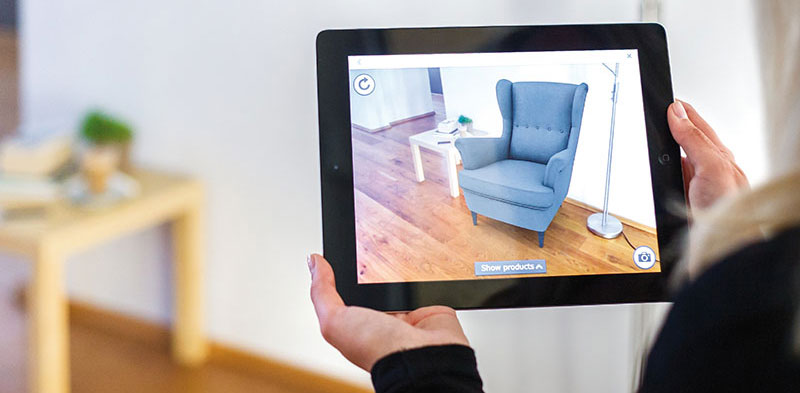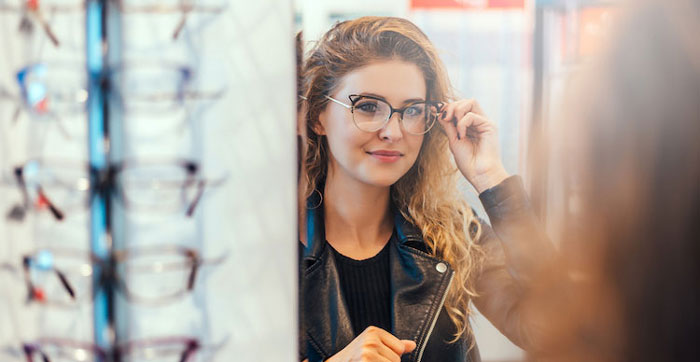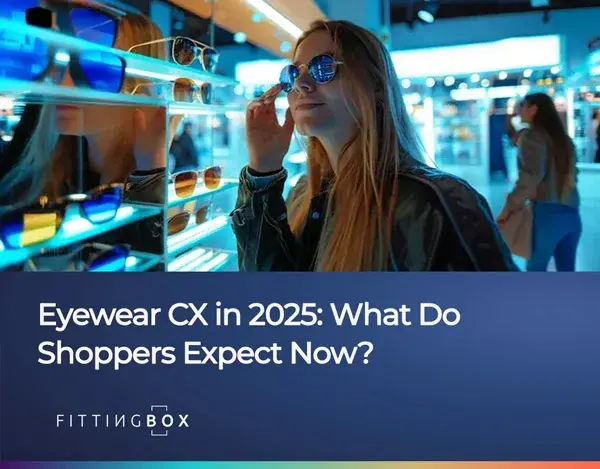.webp)
Eyewear online: Virtual Try-On and Augmented Reality
Popularized by Pokémon Go, augmented reality (AR) is now present in all sectors. Successfully launched in the online ready-to-wear, this technology is now used in e-commerce for cosmetics, furniture, and glasses. In the latter field, home fitting via augmented reality must be considered as a real plus, which enriches the customer experience as well as the relationship between the wearer and the optician.

What is Augmented Reality?
Augmented reality should not be confused with virtual reality. AR consists of superimposing virtual elements in the real world to complete it, unlike virtual reality, which completely immerses the user in a fictional environment. Augmented reality can, therefore, be used with a computer, smartphone or tablet, while virtual reality generally requires a specific mask such as the Oculus Rift or HTC Vive.
Advantages of Augmented Reality in e-commerce
- It allows a real "3D fitting" of the product sold on the Internet as if the consumer were in a physical store. With the camera on his PC or smartphone, he will be able to visualize the product he wants on his silhouette or face, with almost identical precision to a point of sale experience.
- AR removes the uncertainty of the final product rendering, which is the main barrier to buying on the Internet. Removing this uncertainty improves the conversion rate of e-commerce sites highly.
- A virtual fitting in AR can be instantly shared with family and friends to get their opinion on the coveted product, with a reassuring function.
- The VTO can reassure the buyer, that drives to reduce the rate of dissatisfaction and return. It brings a feeling of confidence to the e-commerce website.
- This technology allows the e-merchant to stand out from the competition by offering an original and unique shopping experience. With this experience, customers will memorize the brand in the long term.
- Augmented reality apps entice young consumers, who are familiar with them as users of Snapchat and Instagram.
- The VTO immediately brings the product to life, which gives it emotional value.
Brands are adopting Augmented Reality
- Nike: A pioneer in the use of new technologies, and legendary brand of sports accessories, Nike, has recently integrated the Nike Fit function into its mobile app. This function scans and measures feet to the nearest millimeter to display the size to be selected according to the model chosen by the user.
- Zara: users of the Zara AR app can use their smartphone to target specific areas of the store (marked by totems), or a package of the brand to see animated models wearing the latest collection's clothes, and buy them in a few clicks.
- Sephora : for the Christmas holidays, it opened a 100% RA pop-up store where users of Sephora Collection Experience could bring out an enchanted world with different products, which can be purchased directly online.
- FittingBox: specialist of eyewear virtual try-on offers to optical professionals a variety of solutions combining augmented reality, product modeling, and facial recognition. Its FitMix module, available for all types of e-commerce sites, transforms the screen into a virtual mirror. The user can move and enjoy an ultra-accurate rendering of the frame placed on his face.
- Ikea: thanks to the Ikea Place app, consumers can virtually place a piece of furniture from the brand's catalog in their home to see the effect obtained before buying it from all angles. The size of the product is adapted to the scale of the part.

[Click HERE to learn more about the impact of Virtual Try-On technology on the Eyewear industry]
Adapt Augmented Reality to consumer needs
It is not just a question of proposing augmented reality because it is trendy. To be effective and achieve your objective, namely to boost the sales of your e-commerce site, this technology must meet real needs and have a value in use. "For brands, it is important to take into account three main rules before using augmented reality: realism, fluidity, and durability," explains Stefanos Loukakos, Director of Messenger Business, in an article published in June 2018 in Strategies. The system offered to the customer must, therefore, be seamless. In concrete terms, this means:
- easy to download
- ease of use (in fitting and associated functions such as online shopping)
- intuitiveness (fitting must be possible "as in real life")
The VTO experience must allow for useful and concrete action: testing a lipstick to ensure its harmony with its complexion or appearance, determining its exact size to avoid sore feet in its new sneakers, trying several pairs of glasses to choose the shape that suits us best, etc.
This experience must be almost identical to the one experienced in store: if the result obtained is imprecise, pixelated, of poor quality, the customer will not trust the solution and will turn away from your products and your brand for a long time.
Finally, virtual try-on via augmented reality must be thought of as a mean of building consumer loyalty. It must not be a temporary part of the purchasing process but as a tool for perpetuating customer relations, which implies associating, for example, features of sharing on social networks.
Augmented reality at the service of the opticians
In the optical sector, VTO must be approached concerning the specificities of selling glasses on the Internet:
- the density of the offer: there are now more than 2000 brands, 100,000 frames in several colors, or more than 400,000 references available;
- the variety of prices: from a few euros to several hundred euros depending on the brand and the quality of the product;
- the new collections: each season brings its new batch of models, which forces e-merchants to regularly modify their catalog;
- the relation between the glasses and its wearer: the latter will indeed wear it every day, unlike a garment;
- the frequency of purchase: a pair of corrective glasses is renewed every 2.5 years on average;
- the buyer's questions: what are the new features, trends, shapes, and colors that best suit my face, is this frame style compatible with my vision correction, which sun will be best suited to my sporting activity?
- multiple fittings before the final choice: generally speaking, a customer tries on five frames before making a decision.
Because of these particularities, the eyewear is not a consumer product like any other: it is a fashion accessory, carrying an emotional connection and fitted with several functions (affirmation of style, personality vector, protection, visual correction...). Its health dimension makes it an object that can only be chosen by the consumer if he is accompanied by a professional who will be able to offer him the equipment best suited to his needs, in terms of shape, glasses, etc.
Eyeglass wearers are well aware of this: according to a QualiQuanti Institute survey conducted for the Supercent power plant, 71% of customers appreciate being advised by an optician when choosing a frame and 89% ask for their opinion.

The Virtual Try-On, a tool to prepare the purchase
Given the unique characteristics of eyeglasses, most wearers want to buy theirs in stores to benefit from the optician's expertise in visual acuity. On the other hand, they will most often prepare this purchase on the Internet, from their home or office. It is in this context that optical professionals must integrate virtual fitting into their web strategy.
With the fitting of glasses in augmented reality, wearers will be able to try several shapes and colors of frames to pre-select those they like most, but also choose the store that will offer the most adapted offer to their expectations.
This technology, therefore, helps opticians to differentiate themselves, to attract customers, to bring them to the store, to retain them, but also to save precious time when dealing with customers who will have a clearer idea of their needs.
LET'S TALK
Request a demo, a quote or set up an appointment with one of our sales representatives.
CONTACT USUseful Links
Corporate
© FITTINGBOX 2025 • Terms of use • Privacy & Legal

